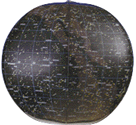BACKGROUND:
 Stars
are a basic unit of the night sky. Recognizing individual stars takes
careful observation. Locating stars on a map is difficult. You can purchase
star charts. However, if you don’t buy the correct latitude and the
correct time of the year you are viewing, you many not find the stars. In
order to locate position patterns of stars were defined.
Stars
are a basic unit of the night sky. Recognizing individual stars takes
careful observation. Locating stars on a map is difficult. You can purchase
star charts. However, if you don’t buy the correct latitude and the
correct time of the year you are viewing, you many not find the stars. In
order to locate position patterns of stars were defined.
The patterns that the stars seem to permanently form
are called constellations. There are 88 recognized constellations that help
locate and map other objects in the sky. Constellations have their roots in
ancient cultures and mythology. These peoples used constellations for
navigation, and to foretell changes in the seasons. Currently,
constellations are used by astronomers and amateurs astronomers to locate
different areas of the night sky.
We cannot see all of the constellations from one point
of the Earth’s surface, because some are located close to the poles. For
example, the North Star, which helps navigators locate geographic north, is
not visible in the Southern Hemisphere.
PROCEDURE:
This exercise allows students to compare different
types of star maps. If you have different star finders, bring them in to show
students.
- Show students the celestial globe model and ask them what it represents. The
Earth inside shows how the different positions on the Earth see
different portions of the Universe. For example, people in Africa see
the southern hemisphere, where Europeans see the northern hemisphere of
the celestial globe.
- Instruct students to read "Twelve Labors of Hercules."
If you have a projection system, read it as a class. You may want
to assign this as homework before this lesson.
- Give each group of students a Constellation
Placemat and inflatable Celestial Globe. First have them locate the
characters of Hercules on the map.
- Provide them a worksheet, so they can compare the two different types of star maps.
- They should discover that the Constellation Placemat is very
simplified whereas the Celestial Globe is very complicated and shows a
complete picture of the night sky throughout the year. The Celestial
Globe outlines all the sectors of the Universe from Earth. The
Constellation Placemat, on the other hand, shows only the constellations
in the Northern Hemisphere. The Placemat doesn't show apparent
brightness, but the Celestial Globe does. The Placemat doesn't show any
galaxies, while the Celestial Globe identifies both their locations and
names. Both maps show stars, but only the Celestial Globe shows nebulas
and clusters. Students should conclude that the Celestial Globe is much
more accurate than the Placemat.